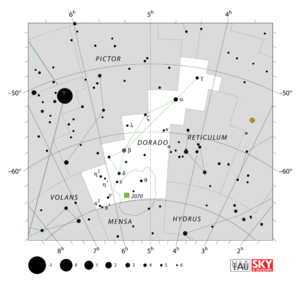Dorado: Difference between revisions
(images added) |
|||
| Line 13: | Line 13: | ||
<gallery> |
<gallery> |
||
File:Dor+vol Bayer1603.jpg|Bayer (1603): Dorado hunts Volans |
File:Dor+vol Bayer1603.jpg|Bayer (1603): Dorado hunts Volans |
||
File:Dorado+volans Dopplmayr1742.jpg|Doppelmayr's (1742) version of Dorado's hunt of Volans |
|||
| ⚫ | |||
| ⚫ | |||
| ⚫ | |||
| ⚫ | |||
File:Dor+Vol+Arg Bode1772.jpg|Bode (1772) depicts Dorado hunting Volans next to Argo. |
File:Dor+Vol+Arg Bode1772.jpg|Bode (1772) depicts Dorado hunting Volans next to Argo. |
||
File:Dorado Bode1772.jpg|Bode (1772) labels Dorado "Schwerdt-Fisch" (swordfish) |
File:Dorado Bode1772.jpg|Bode (1772) labels Dorado "Schwerdt-Fisch" (swordfish) |
||
File:Dor+Vol Fortin 1776-1795.jpg|Fortin's hunt of Volans by Dorado (1775-1795) |
|||
| ⚫ | |||
| ⚫ | |||
| ⚫ | |||
| ⚫ | |||
</gallery> |
</gallery> |
||
Revision as of 20:26, 5 June 2024
one of the 88 official constellations. The Spanish term "dorado" means "golden", and it has been used for various type of fish in the past. Given this translation, the constellation name has sometimes been translated as "Goldfish", although the Spanish term always designated exotic fish species from the "new worlds".
Etymology and History
Dorado, the Dolphinfish, has been invented by Pieter Keyser and Frederik de Houtman on their journey to Indonesia (later called "Dutch Indies") 1592-1594. Their catalogue of southern stars was published by de Houtman in 1603 as an appendix to a dictionary of the Malaysian (and other) language(s). This star catalogue was written in Dutch and never translated. Before the publication of the star catalogue, de Houtman has shared his data with Petrus Plancius, who had actually commissioned this work. Even in the 1590s, Plancius had worked with this material and his celestial globe of 1598 already displayed paintings of the newly invented constellations in the south, and so did Johann Bayer's Uranometria (1603).
Species of Fish
Despite translating the Spanish term "dorado" (golden), historical Spanish and other European languages never designated any species of goldfish (small freshwater pet fish) with the term.
In biology, "Dorado" is the name of two sorts of fish: a freshwater fish in South America and a predatory fish that lives in the ocean. The ocean inhabitants, who had inspired de Houtman and Keyser, are today known as dolphinfishes with the scientific genus name "Coryphaena". The "Common Dolphinfish" (Coryphaena hippurus) is called Mahi Mahi, the Hawaiian language term for "very strong". In Persian, the word "mahi" (ماهی) happens to mean "fish" which is unrelated to the Hawaiian term. Although there are other names for the fish in some regions (e.g. "Lampuka" on the Mediterranean island of Malta and specifically "Ikan Lemadang" in Indonesia, where de Houtman and Keyser invented the celestial name), the Hawaiian term became publicly known. To avoid confusion with dolphins (the sea mammals who are unrelated to all species of fish), the term for the fish that is used in the public, e.g. in restaurants, is Mahi Mahi.
Modern transformations
References
- Ian Ridpath, Star Tales. website
- Frederik de Houtman (1603) Star Catalogue concerning the Indian Magpie
- Alfred Maass, ``Sternkunde und Sterndeuterei im malaiischen Archipel'', Tijdschrift voor Indische Taal-, Land- en Volkenkunde, vol. 64 (1924), pp. 1-172 & 347-459, with a "Nachtrag", vol. 66 (1926), pp. 618-670.














